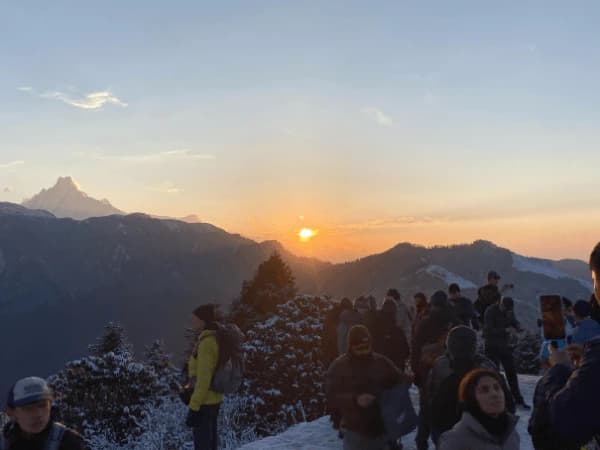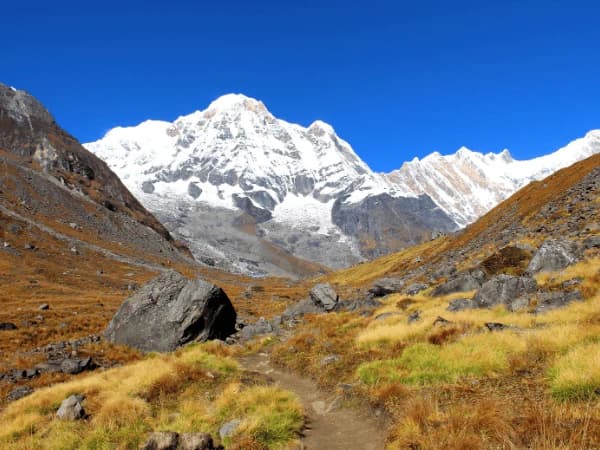National Park Trekking in Nepal is an invitation to step into wild Himalayan landscapes, diverse ecosystems, and ancient cultures. From the icy giants of Sagarmatha National Park to the tranquil trails of Langtang and the vibrant Annapurna Conservation Area, these treks offer unforgettable experiences for both seasoned adventurers and first-time hikers. This guide explores the best trails, what makes each park unique, and why trekking in Nepal’s protected areas is a journey like no other.
Must Go National Park Trekking in Nepal
Best National Park Trekking Trails in Nepal
Nepal’s national parks and conservation areas are the lifeblood of its trekking culture, offering more than just mountain vistas. They protect rare wildlife like snow leopards and red pandas, cradle centuries-old monasteries, and open up pathways where nature and culture combine. In this blog, we bring you the top National Park Trekking in Nepal that leads you to some of the highest peaks in the world.
From the adrenaline of the Everest region to the serenity of Rara National Park, each protected area is distinct. Sagarmatha National Park showcases the towering drama of the Khumbu, while Langtang National Park blends alpine wilderness with vibrant Tamang villages. The Annapurna Conservation Area weaves together lush rhododendron forests and high passes, and Makalu Barun and Kanchenjunga remain remote frontiers for true explorers. Whether you dream of the classic Everest Base Camp Trek, a meditative walk to Gosainkunda, or the hidden gems of the Manaslu region, Nepal’s national parks hold trails that reward every step with inspiration.
Sagarmatha National Park (Everest Region)
Sagarmatha National Park is perhaps Nepal’s most iconic protected area, home to the legendary Mount Everest (Sagarmatha in Nepali). Established in 1976 and declared a UNESCO World Heritage Site in 1979, the park spans over 1,148 square kilometers of alpine terrain. Trekkers encounter dramatic glaciers, deep valleys carved by the Dudh Koshi River, and a culture shaped by centuries of Sherpa tradition. The region is famous not only for Everest Base Camp but also for routes like Gokyo and the Three Passes, offering panoramic views of the world’s highest peaks, including Lhotse, Nuptse, and Ama Dablam. Wildlife sightings are common, from Himalayan tahr grazing along rocky slopes to colorful Danphe pheasants flitting through juniper. Sagarmatha’s blend of rugged landscapes and spiritual heritage makes it a must-visit for adventurers seeking a profound connection to the Himalayas. Here is the list of trek that goes through the Sagaramatha National Park.
Everest Base Camp Trek
The Everest Base Camp Trek is a rite of passage for trekkers worldwide. Beginning with a thrilling flight to Lukla, this journey winds through Namche Bazaar, the Sherpa capital, and ascends past Tengboche Monastery, a place of deep spiritual resonance. As you climb higher, the landscape transforms: lush forests give way to glacial moraine and lunar-like expanses above Dingboche. Each day’s walk brings the towering south face of Everest closer into view.
At 5,364 meters, Everest Base Camp itself is a place of raw grandeur, surrounded by icefall seracs and prayer flags fluttering in the thin air. This trek not only challenges the body but also humbles the spirit. Along the way, trekkers share warm tea in stone lodges, learn Sherpa traditions, and experience the thrill of standing at the foot of the highest mountain on Earth. The Everest Base Camp Trek in Sagarmatha National Park is a dream etched in snow and stone, inspiring generations of explorers.
Gokyo Valley Trek
The Gokyo Valley Trek offers an alternative path through Sagarmatha National Park, away from the busier trails of Everest Base Camp. This route takes you past serene turquoise lakes that mirror the surrounding peaks, most notably Gokyo Ri, which offers one of the finest panoramic views in Nepal. From its summit, you see Everest, Lhotse, Makalu, and Cho Oyu rising in a jagged skyline.
Trekkers also cross the Ngozumpa Glacier, Nepal’s longest, and overnight in quiet villages like Machhermo and Gokyo. Compared to the EBC trek, Gokyo feels more meditative, with fewer crowds and a sense of timeless tranquility. This journey is perfect for trekkers seeking dramatic landscapes, high-altitude adventure, and moments of reflection amid Himalayan splendor.
Everest Three High Passes Trek
Those trekkers who want to push beyond their limit, the Everest Three High Passes Trek is the ultimate challenge in Sagarmatha National Park. This epic circuit includes three formidable passes, Kongma La (5,535m), Cho La (5,420m), and Renjo La (5,360m), linking the Khumbu, Gokyo, and Imja Valleys.
Along the way, you’ll traverse glaciers, climb viewpoints like Kala Patthar, and camp under star-filled skies. Each pass rewards you with surreal vistas and the satisfaction of crossing some of the highest trekking routes in Nepal. The Three Passes Trek is demanding but delivers an unforgettable immersion into the heart of the Everest region, combining adventure with cultural discovery.
Langtang National Park (Langtang Region)
Langtang National Park, Nepal’s first Himalayan national park, was established in 1976 and spans 1,710 square kilometers. It’s an accessible yet wild region just north of Kathmandu, famous for its diversity: dense oak forests, alpine meadows, and soaring peaks like Langtang Lirung. The park is a haven for wildlife, including red pandas and Himalayan black bears. Culturally, the Tamang people, descendants of Tibetan migrants, infuse the region with rich traditions and warm hospitality. With treks ranging from the classic Langtang Valley to the sacred lakes of Gosainkunda and the lesser-traveled Helambu, Langtang National Park remains a soulful destination for those seeking nature and culture in equal measure.
Langtang Valley Trek
The Langtang Valley Trek is the crown jewel of the region, offering a compact journey through diverse landscapes. Starting in Syabrubesi, the trail follows the Langtang Khola River past bamboo groves and waterfalls. As you ascend, pine forests give way to yak pastures and glacial valleys.
Kyanjin Gompa, the trek’s spiritual heart, sits beneath the icy ramparts of Langtang Lirung. Trekkers often climb Kyanjin Ri or Tserko Ri for sunrise panoramas stretching to the Tibetan border. Rebuilt after the 2015 earthquake, Langtang’s villages now stand as a testament to resilience and community spirit.
Tamang Heritage Trail Trek
The Tamang Heritage Trail offers a culturally immersive experience through villages that showcase traditional Tamang architecture, customs, and handicrafts. Beginning near Syabrubesi, this trek traverses terraced hillsides and hot springs at Tatopani.
The route includes Gatlang and Briddim, where homestays provide insight into local life. Unlike higher-altitude treks, this journey stays at moderate elevations, making it accessible year-round. It’s perfect for trekkers who prioritize cultural discovery and gentle landscapes over high passes.
Gosainkunda Trek
The Gosainkunda Trek is a pilgrimage route to a cluster of sacred alpine lakes believed to have been created by Lord Shiva. Starting from Dhunche or Sundarijal, the trail ascends through rhododendron forests and windswept ridges.
At over 4,300 meters, the lakes shimmer like blue sapphires against a backdrop of snow peaks. Each August, pilgrims gather here during Janai Purnima to bathe in the frigid waters. The trek can be combined with the Helambu Trail for a longer journey through diverse landscapes.
Helambu Trek
The Helambu Trek explores the lower Langtang region, famous for its sweet apples, Buddhist monasteries, and Sherpa villages. Beginning near Sundarijal or Melamchi Pul Bazaar, the trail passes Chisapani and Tharepati before descending to Melamchi Gaon.
With moderate elevations and shorter duration, Helambu is ideal for trekkers seeking gentle terrain, cultural experiences, and stunning views without the physical demands of higher-altitude routes.
Also, DO YOU KNOW, besides trekking in a national park, you can also visit two popular National parks of Nepal for the wildlife exploration, i.e., Chitwan National Park & Bardiya National Park.
Trek to the Popular Conservation Areas of Nepal
Beyond national parks, Nepal’s conservation areas protect breathtaking biodiversity and cultural heritage. These zones, such as Annapurna, Manaslu, and Kanchenjunga, offer some of the most famous trekking circuits in the Himalayas. Managed with community involvement, conservation areas balance tourism, environmental protection, and local livelihoods. From the terraced fields of the Annapurna foothills to the remote glaciers of Manaslu, these trails provide a kaleidoscope of landscapes, each with its own character and allure.
Annapurna Conservation Area
The Annapurna Conservation Area is Nepal’s largest protected region, spanning 7,629 square kilometers. It’s home to legendary treks like the Annapurna Base Camp Trek, which ascends through bamboo forests to a natural amphitheater surrounded by towering peaks. The Annapurna Circuit Trek circumnavigates the massif, crossing the 5,416-meter Thorong La Pass.
Shorter options like the Mardi Himal Trek and the Poon Hill Trek offer breathtaking views and cultural encounters without the rigors of higher elevations. Annapurna’s diversity, from tropical valleys to glaciated peaks, makes it an epic venture of Himalayan trekking.
Manaslu Conservation Area
The Manaslu Conservation Area remains one of Nepal’s most rewarding off-the-beaten-path trekking regions. Centered on the world’s eighth-highest peak, Manaslu (8,163m), this area is renowned for its pristine valleys and Tibetan-influenced villages.
Treks here include the Manaslu Base Camp Trek, the Tsum Valley Trek, an isolated Buddhist enclave, and the full Manaslu Circuit Trek, which crosses the challenging Larkya La Pass at 5,106 meters. Compared to Annapurna or Everest, Manaslu is less crowded, making it perfect for trekkers seeking solitude and authentic cultural immersion.
FAQs
Do I need permits for trekking in Nepal’s national parks?
Yes, you need both a TIMS (Trekkers’ Information Management System) card and specific park permits, such as the Sagarmatha National Park Entry Permit or Annapurna Conservation Area Permit.
What is the best season for national park trekking?
Spring (March–May) and autumn (September–November) offer the clearest skies and comfortable temperatures, making it the best time to trek in Nepal.
Are guided treks mandatory in conservation areas?
As per the Government rules and Nepal Tourism Board, trekkers need to hire a guide to enter the National Park, Conservation Areas, and Restricted Areas of Nepal.
Which trek is best for beginners in Nepal?
Poon Hill, Langtang Valley, and Helambu Treks are great for first-timers due to their moderate elevations and accessible trails.
Can I combine multiple regions in one trek?
Yes, some itineraries combine circuits, such as Annapurna Circuit with Tilicho Lake or Langtang with Gosainkunda and Helambu.
Conclusion
National Park Trekking in Nepal is more than a physical journey; it’s a soulful exploration of landscapes, wildlife, and centuries-old cultures. Whether you dream of reaching Everest Base Camp, the sacred lakes of Gosainkunda, or the lush rhododendron forests of Annapurna, Nepal’s protected areas offer experiences that stay etched in your heart forever. Overland Trek Nepal has organized the popular National Park Trek in Nepal for the last decade. If you want to explore the Himalayas along with the Wildlife at the same time, contact us today via email or WhatsApp at +9779851138871. Our experienced guide will take you through the national park to the epic Himalayas with all the safety and experience.




